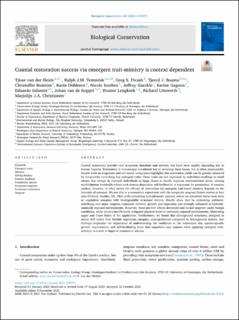| dc.description.abstract | Coastal ecosystems provide vital ecosystem functions and services, but have been rapidly degrading due to human impacts. Restoration is increasingly considered key to reversing these losses, but is often unsuccessful. Recent work on seagrasses and salt marsh cordgrasses highlights that restoration yields can be greatly enhanced by temporarily mimicking key emergent traits. These traits are not expressed by individual seedlings or small clones, but emerge in clumped individuals or large clones to locally suppress environmental stress, causing establishment thresholds where such density-dependent self-facilitation is important for persistence. It remains unclear, however, to what extent the efficacy of restoration via emergent trait-based mimicry depends on the intensity of stressors. We test this in a restoration experiment with the temperate seagrass Zostera marina at four sites (Finland, Sweden, UK, USA) with contrasting hydrodynamic regimes, where we simulated dense roots mats or vegetation canopies with biodegradable structural mimics. Results show that by mimicking sediment-stabilizing root mats, seagrass transplant survival, growth and expansion was strongly enhanced in hydrodynamically exposed environments. However, these positive effects decreased and turned negative under benign conditions, while mimics insufficiently mitigated physical stress in extremely exposed environments, illustrating upper and lower limits of the application. Furthermore, we found that aboveground structures, designed to mimic stiff rather than flexible vegetation canopies, underperformed compared to belowground mimics. Our findings emphasize the importance of understanding the conditions at the restoration site, species-specific growth requirements, and self-facilitating traits that organisms may express when applying emergent trait-mimicry as a tool to improve restoration success. | en_US |

